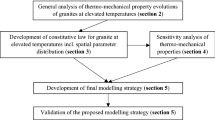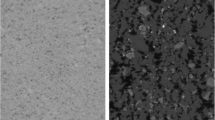Abstract
This paper presents a rate-independent analytical model for porous Tresca (\(J_{3}\)-dependent) materials containing general ellipsoidal voids. The model is based on the nonlinear variational homogenization method which uses a linear comparison material to estimate the response of the nonlinear porous solid and is denoted as “MVAR”. Specifically, the model is derived by an original approach starting from a novel porous single crystal model (Mbiakop et al. in Int J Solids Struct 64–65:100–119, 2015b, J Mech Phys Solids 84:436–467, 2015c) by considering the limiting case of infinite slip systems which leads readily to the corresponding Tresca criterion. The MVAR yield surface is then validated using FEM on different unit-cells and various parameters including several porosity levels, several stress triaxiality ratios, different Lode angle and general void shapes and orientations. The MVAR model is found to be in good agreement with the finite element results for all cases considered in this study. Both the MVAR and the FEM computations reveal a strong sensitivity upon the microstructure anisotropy (void shape and orientation), and a dependence of the effective behavior on the third invariant of the applied stress. To the best knowledge of the authors, this is the first model in the literature that is able to deal with porous Tresca material and general void shapes and orientations. Moreover, the MVAR is used in a predictive manner to investigate the complex response of porous Tresca cases with strong coupling between the \(J_{3}\)-dependent matrix behavior and the (morphological) anisotropy induced by the shape and orientation of the voids. The simplicity of the present analytical study opens the possibility to adapt the present model to experimental results for various materials.














Similar content being viewed by others
References
Abaqus (2009) ABAQUS/Standard Version 6.9, user manual. Simulia Corp
Agoras M, Ponte Castañeda P (2013) Iterated linear comparison bounds for viscoplastic porous materials with ellipsoidal microstructures. J Mech Phys Solids 61:701–725
Agoras M, Ponte Castañeda P (2014) Anisotropic finite-strain models for porous viscoplastic materials with microstructure evolution. Int J Solids Struct 51:981–1002
Aravas N, Ponte Castañeda P (2004) Numerical methods for porous metals with deformation-induced anisotropy. Comput Methods Appl Mech Engrg 193:3767–3805
Barsoum I, Faleskog J (2007) Rupture mechanisms in combined tension and shear—micromechanics. Int J Solids Struct 44:5481–5498
Benallal A (2015) On some features of the effective behavior of porous solids with general incompressible matrix behavior. CR, Mecanique
Cao TS, Maziere M, Danas K, Besson J (2015) A model for ductile damage prediction at low stress triaxialities incorporating void shape change and void rotation. Int J Solids Struct 63:240–263
Cazacu O, Revil-Baudard B, Chandola N, Kondo D (2014) New analytical criterion for porous solids with Tresca matrix under axisymmetric loadings. Int J Solids Struct 51:861–874
Cohen T, Masri R, Durban D (2009) Analysis of circular hole expansion with generalized yield criteria. Int J Solids Struct 46:3643–3650
Danas K (2008) Porous materials with evolving microstructure: constitutive modeling, numerical implementation and applications, PhD thesis, Ecole Polytechnique de Paris
Danas K, Aravas N (2012) Numerical modeling of elasto-plastic porous materials with void shape effects at finite deformations. Compos B 43:2544–25
Danas K, Ponte Castañeda P (2009) A finite-strain model for anisotropic viscoplastic porous media: I-theory. Eur J Mech A/Solids 28:387–401
Danas K, Ponte Castañeda P (2009) A finite-strain model for anisotropic viscoplastic porous media: II-applications. Eur J Mech A/Solids 28:402–416
Danas K, Idiart M, Ponte Castañeda P (2008) A homogenization-based constitutive model for two-dimensional viscoplastic porous media. C R Mec 336:79–90
Danas K, Idiart M, Ponte Castañeda P (2008) A homogenization-based constitutive model for isotropic viscoplastic porous media. Int J Solids Struct 45:3392–3409
DeBotton G, Ponte Castañeda P (1995) Variational estimates for the creep behaviour of polycrystals. Proc R Soc Lond A Math Phys Eng Sci 448:121–142
Drucker D (1949) Relation of experiments to mathematical theories of plasticity. J App Mech 16:349–357
Eshelby JD (1957) The determination of the elastic field of an ellipsoidal inclusion and related problems. Proc R Soc Lond A 241:376–396
Fritzen F, Forest S, Bohlke T, Kondo D, Kanit T (2012) Computational homogenization of elasto-plastic porous metals. Int J Plast 29:102–119
Gilormini P, Michel JC (1998) Finite element solution of the problem of a spherical inhomogeneity in an infinite power-law viscous matrix. Eur J Mech A/Solids 17:725–740
Gologanu M, Leblond JB (1993) Approximate models for ductile metals containing non-spherical voids—case of axisymmetric prolate ellipsoidal cavities. J Mech Phys Solids 41:1723–1754
Gurson AL (1977) Continuum theory of ductile rupture by void nucleation and growth. J Eng Mater Tech 99:2–15
Han X, Besson J, Forest S, Tanguy B, Bugat S (2013) A yield function for single crystals containing voids. Int J Solids Struct 50:2115–2131
Hashin Z (1962) The elastic moduli of heterogeneous materials. J Appl Mech 29:143–150
Hershey AV (1954) The elasticity of an isotropic aggregate of anisotropic cubic crystal, ASME. J Appl Mech 21:236–240
Hosford WF (1972) A generalized isotropic yield criterion. J Appl Mech 39:607–609
Kailasam M, Ponte Castañeda P (1998) A general constitutive theory for linear and nonlinear particulate media with microstructure evolution. J Mech Phys Solids 46:427–465
Leblond J, Perrin G, Suquet P (1994) Exact results and approximate models for porous viscoplastic solids. Int J Plasticity 10:213–235
Lopez-Pamies O, Goudarzi T, Danas K (2013) The nonlinear elastic response of suspensions of rigid inclusions in rubber: II-A simple explicit approximation for finite-concentration suspensions. J Mech Phys Solids 61:19–37
Mbiakop A, Constantinescu A, Danas K (2015a) On void shape effects of periodic elasto-plastic materials subjected to cyclic loading. Eur J Mech Solids 49:481–499
Mbiakop A, Constantinescu A, Danas K (2015b) A model for porous single crystals with cylindrical voids of elliptical cross-section. Int J Solids Struct 64–65:100–119
Mbiakop A, Constantinescu A, Danas K (2015c) An analytical model for porous single crystals with ellipsoidal voids. J Mech Phys Solids 84:436–467
Michel J-C, Moulinec H, Suquet P (1999) Effective properties of composite material with periodic microstructure: a computational approach. Comput Methods Appl Mech Engrg 172:109–143
Miehe C, Schroder J, Schotte J (1999) Computational homogenization analysis in finite plasticity simulation of texture development in polycrystalline materials. Comput Methods Appl Mech Engrg 171:387–418
Monchiet V, Charkaluk E, Kondo D (2007) An improvement of gurson-type models of porous materials by using eshelby-like trial velocity fields, C.R. Acad Sci Paris 335:32–41
Ponte Castañeda P (1991) The effective mechanical properties of nonlinear isotropic composites. J Mech Phys Solids 35:45–71
Ponte Castañeda P, Willis JR (1995) The effect of spatial distribution on the effective behavior of composite materials and cracked media. J Mech Phys Solids 43:1919–1951
Ponte Castañeda P (2002) Second-order homogenization estimates for nonlinear composites incorporating field fluctuations: I-theory. J Mech Phys Solids 50:737–757
Revil-Baudard B, Cazacu O (2014) New three-dimensional strain-rate potentials for isotropic porous metals: role of the plastic flow of the matrix. Int J Plasticity 60:101–117
Rintoul MD, Torquato S (1997) Reconstruction of the structure of dispersions. J Colloid Interface Sci 186:467–476
Segurado J, Llorca J (2002) A numerical approximation to the elastic properties of sphere-reinforced composites. J Mech Phys Solids 50:2107–2121
Torquato S (2002) Random heterogeneous materials: micorstructures and macroscopic properties. Springer, New York
Tvergaard V, Needleman A (1984) Analysis of the cup-cone fracture in a round tensile bar. Acta Metall 32:157–169
Vincent P, Suquet P, Monerie Y, Moulinec H (2014) Effective flow surface of porous materials with two populations of voids under internal pressure: II. Full-field simulations. Int J Plasticity 56:74–98
Willis JR (1977) Bounds and self-consistent estimates for the overall properties of anisotropic composites. J Mech Phys Solids 25:185–202
Author information
Authors and Affiliations
Corresponding author
Appendix: Microstructural tensor in the limiting case of \(K \rightarrow \infty \) (isotropic Tresca matrix)
Appendix: Microstructural tensor in the limiting case of \(K \rightarrow \infty \) (isotropic Tresca matrix)
In the case of slip systems with identical CRSS \(\tau _0\) and reference slip-rate \(\dot{\gamma }_0\), the compliance tensor \(\mathbf {S}_{K}\) of the linear comparison composite is given in Mbiakop et al. (2015b, c) by setting \(\lambda ^{(s)}=\lambda \) and \(\rho ^{(s)}=\rho \),
\(\forall s=1,K\), where \(\lambda ,\,\rho ,\,\kappa \) serve to denote eigenvalues. While \(\lambda \) is optimized in the context of the variational homogenization method, \(\rho ,\,\kappa \) are set to infinity [see more details in Mbiakop et al. (2015c)].
In addition, the microstructural tensor can easily be computed in the case of an isotropic von Mises compliance matrix, whose compliance tensor of the corresponding linear comparison composite is \(\mathbf {S}_{Mises} = (2 \mu _0)^{-1}\mathbf {K} + (3\kappa _0)^{-1}\mathbf {J}\)), following for instance the numerical framework described in Aravas and Ponte Castañeda (2004) and Danas (2008).
Moreover, the numerical computation of the hydrostatic part of \(\mathbf {S}^{*}/K\) in the infinite number of slip systems context (i.e. Tresca matrix) for spherical voids leads to a result (up to \(2\,\%\)) close to the microstructural tensor associated with the compliance tensor of a von Mises matrix. In addition, it was shown Benallal (2015) and we observe through FE simulations that a porous von Mises material and a porous Tresca material exhibit the same hydrostatic point. Hence, one can, as a first approximation, use the tensor \(\mathbf {S}_{Mises}\) instead of \(\mathbf {S}\) in the limiting case \(K \rightarrow \infty \). Suitable values for \(\mu _0\) and \(\kappa _0\) must consequently be used. In order to achieve this goal, the deviatoric and hydrostatic projections of both tensors lead to
Thus, using the identity (18), one can readily show that in the limit \(\rho \rightarrow \infty \), \(\kappa \rightarrow \infty \) and \(K \rightarrow \infty \), the microstructural tensor \(\widehat{\mathbf {S}}^{*}_{K}\) leads to equation (7).
Rights and permissions
About this article
Cite this article
Mbiakop, A., Danas, K. & Constantinescu, A. A homogenization based yield criterion for a porous Tresca material with ellipsoidal voids . Int J Fract 200, 209–225 (2016). https://doi.org/10.1007/s10704-015-0071-9
Received:
Accepted:
Published:
Issue Date:
DOI: https://doi.org/10.1007/s10704-015-0071-9




